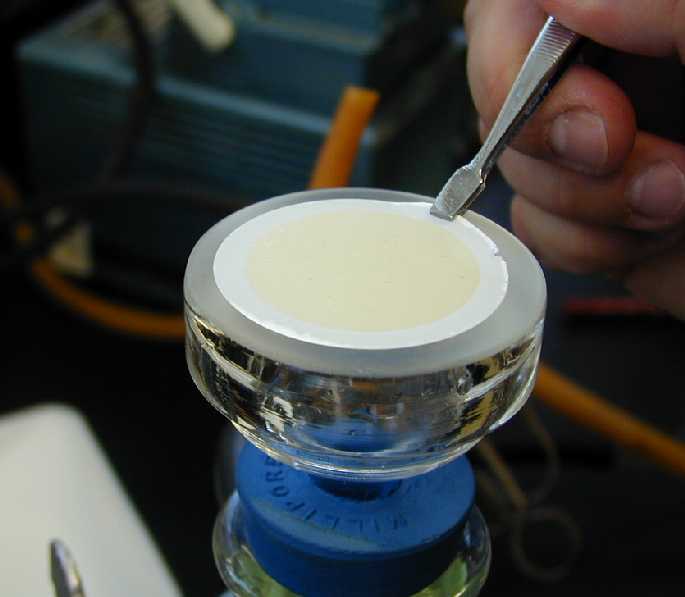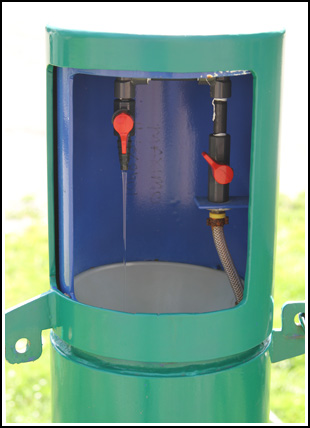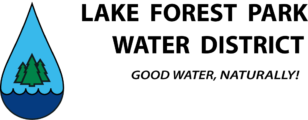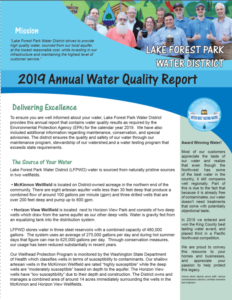Water Source
The water supplied to customers in LFPWD is normally sourced from wells within the district. Five deep wells provide the bulk of supply, and eight shallow artesian wells provide supplemental supply. In case of extreme fire situations we also have emergency connections with Seattle Public Utilities (SPU) and Northshore Utilites (NUD), however this water does not normally enter our system.
Studies of the deep aquifer indicate that water flows from north to south and eventually empties into Lake Washington in the form of underwater springs. Water is captured as rain falls in the vicinity of Brier to the north, and it is naturally filtered as it percolates through the soil, eventually becoming the pristine water you enjoy.
You can read more in-depth about our sources in our 2016 Aquifer Study.
Aquifer Map
Water Quality
Lake Forest Park Water District staff & commissioners are committed to meeting the most stringent and most recent regulatory standards. At the same time we recognize most of our customer's long standing appreciation and desire for naturally pure, chemical free (eg. chlorine, fluoride) water, and we will do our best to meet this expectation. The District's customers are fortunate to have their own protected artesian & deep well sources which continue to produce high quality water, and show no signs of deterioration over close to a century of use.

In-House Water analysis
Our water is even more closely monitored for harmful bacteria now that we have in-house bacteriological testing. We are using industry standard membrane filtration methods to determine if our water has become contaminated by coliform bacteria which are normally found only in the gut of warm blooded animals. This is the standard test that the Department of Health (DOH) requires of all water districts to ensure water safety. Specifically, based on our size, the DOH requires our district to obtain the results from 3 samples per month, which we continue to have analyzed at a certified lab.
Our in-house sampling allows closer monitoring for engineering purposes and allows timely analysis (results in under 24 hours) while giving us savings in fuel expenses and lab fees. We are excited about this development and are sure that as our customers you will appreciate our committment to providing clean and naturally pure water!
Below are test results as required for compliance with State & Federal water quality assurance programs.
Water Quality Summary (IOC's)
| Parameter | 2000 | 2007 | 2011 | 2019 | Max Allowed |
|---|---|---|---|---|---|
| Hardness (CaCO3) | 150 mg/L | 93 mg/L | 92.8 mg/L | 101.1 mg/L | - |
| pH | 7.2 | 7.61 | - | - | - |
| Calcium | 23 mg/L | 14 mg/L | - | - | - |
| Magnesium | 22 mg/L | 14 mg/L | - | - | - |
| Manganese | ND | .0117 mg/L | .022 mg/L | .012 mg/L | .05 mg/L |
| Iron | ND | .123 mg/L | .15 mg/L | .08 mg/L | .3 mg/L |
| Water Hardness Reference | ||
|---|---|---|
| 0-17 mg/L | Soft | |
| 17-60 mg/L | Slightly Hard | |
| 60-120 mg/L | Moderately Hard | |
| 120-180 mg/L | Hard | |
| > 180 mg/L | Very Hard | |
Nitrate Testing Results
Typical Bacterial Testing Results
Washington State Dept. of Health Records (System ID 40950K)

Per- and Polyfluoroalkyl Substances (PFAS)
Tested water sources November 2023 with no detection of PFAS group chemicals.
More information about PFAS from WSDOH
US EPA explains PFAS
Consumer Confidence Reports (CCR)
This report provides information on the quality of your drinking water over the past year. We send this update to our customers each year. If you have any questions or comments please call Lake Forest Park Water District at (206) 365-3211.
The U.S. Environmental Protection Agency (EPA) requires water suppliers to put annual drinking water quality reports into the hands of their customers. These consumer confidence reports, which EPA developed in consultation with water suppliers, environmental groups, and the states, will enable Americans to make practical, knowledgeable decisions about their health and their environment. (more info)
Tips For Saving Water
Indoor:
- Run the dishwasher only when full.
- Locate your master water shut-off valve in case a pipe bursts and you need to shut if off to avoid flooding.
- Insulate your water pipes, you'll get hot water faster.
- Don't let the water run while brushing your teeth.
- Fix leaking faucets and toilets. Research has shown that an average of 8% (or more) of all home water use is wasted through leaks.
- Test for a leaking toilet by lifting the lid off the toilet tank and putting a few drops of food coloring into the bowl. Wait a few minutes, then look in the bowl. If the food coloring has made its way there, you have a leak. (we have dye tablets available as well)
Outdoor:
- Use a broom instead of a hose to clean your driveway and sidewalk.
- If you wash your own car, use a hose nozzle and turn off the water while you soap up your car. Use phosphorous-free soap. It's better for the environment.
- Direct downspouts toward shrubs or trees
- Use a timer when watering. It is easy to forget and over water.
- Water your lawn in the early morning or in the evening when there is less evaporation.
- Don't water on windy days. Water is lost to evaporation or can be blown away from plants. If your sprinklers water the sidewalk, driveway or street, that's another 300 gallons down the drain!
- Deep soak your lawn. Water infrequently but thoroughly so that moisture soaks deep to the roots. This encourages deeper, healthier root systems and allows the lawn to go without irrigation for a longer period of time.
The District's Policies on water conservation


